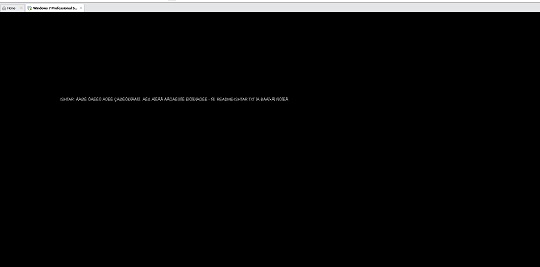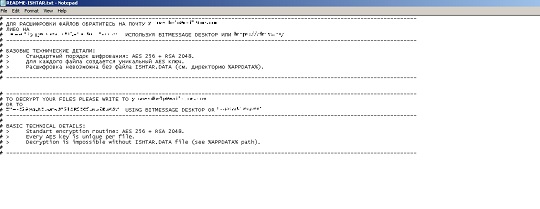Ransom.AutoIt.ISHTAR.A
Trojan-Ransom.Win32.Ishtar.dc (KASPERSKY)
Windows


Threat Type: Ransomware
Destructiveness: No
Encrypted: Yes
In the wild: Yes
OVERVIEW
This Ransomware arrives on a system as a file dropped by other malware or as a file downloaded unknowingly by users when visiting malicious sites.
It steals email account information. It retrieves specific information from the affected system.
It encrypts files with specific file extensions. It drops files as ransom note.
TECHNICAL DETAILS
Arrival Details
This Ransomware arrives on a system as a file dropped by other malware or as a file downloaded unknowingly by users when visiting malicious sites.
Installation
This Ransomware drops the following copies of itself into the affected system and executes them:
- %Application Data%\{5-12 Random Alphanumeric Characters}.exe
(Note: %Application Data% is the current user's Application Data folder, which is usually C:\Documents and Settings\{user name}\Application Data on Windows 2000(32-bit), XP, and Server 2003(32-bit), or C:\Users\{user name}\AppData\Roaming on Windows Vista, 7, 8, 8.1, 2008(64-bit), 2012(64-bit) and 10(64-bit).)
It drops the following file(s)/component(s):
- %Desktop%\{Malware File Name}.docx → Contains the generated 5-12 random alphanumeric characters
- %Application Data%\ISHTAR.DATA → Contains a generated key
- {Drive Letter}:\ISHTAR.DATA → Contains a generated key
(Note: %Desktop% is the current user's desktop, which is usually C:\Documents and Settings\{User Name}\Desktop on Windows 2000(32-bit), XP, and Server 2003(32-bit), or C:\Users\{user name}\Desktop on Windows Vista, 7, 8, 8.1, 2008(64-bit), 2012(64-bit) and 10(64-bit).. %Application Data% is the current user's Application Data folder, which is usually C:\Documents and Settings\{user name}\Application Data on Windows 2000(32-bit), XP, and Server 2003(32-bit), or C:\Users\{user name}\AppData\Roaming on Windows Vista, 7, 8, 8.1, 2008(64-bit), 2012(64-bit) and 10(64-bit).)
It drops and executes the following files:
- %Application Data%\{5-12 Random Alphanumeric Characters}.tmp → Contains the decrypted payload
(Note: %Application Data% is the current user's Application Data folder, which is usually C:\Documents and Settings\{user name}\Application Data on Windows 2000(32-bit), XP, and Server 2003(32-bit), or C:\Users\{user name}\AppData\Roaming on Windows Vista, 7, 8, 8.1, 2008(64-bit), 2012(64-bit) and 10(64-bit).)
It adds the following processes:
- %System%\cmd.exe /c "%Desktop%\{Malware File Name}.docx"
- %Application Data%\{5-12 Random Alphanumeric Characters}.exe
- %System%\cmd.exe /c ping -n 1 localhost > nul & del /f /q "{Malware File Path}\{Malware File Name}.exe"
- "%Application Data%\{5-12 Random Alphanumeric Characters}.exe" /AutoIt3ExecuteScript "%Application Data%\{5-12 Random Alphanumeric Characters}.tmp
- %System%\cmd.exe /c whoami /all
- "%System%\eventvwr.exe"
- "%System%\cmd.exe /c vssadmin delete shadows /all /quiet
(Note: %Desktop% is the current user's desktop, which is usually C:\Documents and Settings\{User Name}\Desktop on Windows 2000(32-bit), XP, and Server 2003(32-bit), or C:\Users\{user name}\Desktop on Windows Vista, 7, 8, 8.1, 2008(64-bit), 2012(64-bit) and 10(64-bit).. %Application Data% is the current user's Application Data folder, which is usually C:\Documents and Settings\{user name}\Application Data on Windows 2000(32-bit), XP, and Server 2003(32-bit), or C:\Users\{user name}\AppData\Roaming on Windows Vista, 7, 8, 8.1, 2008(64-bit), 2012(64-bit) and 10(64-bit).)
Autostart Technique
This Ransomware adds the following registry entries to enable its automatic execution at every system startup:
HKEY_CURRENT_USER\Software\Microsoft\
Windows\CurrentVersion\Run
(Default) = %Application Data%\{5-12 Random Alphanumeric Characters}.exe
Other System Modifications
This Ransomware adds the following registry entries:
HKEY_CURRENT_USER\Software\Classes\
mscfile\shell\open\
command
(Default) = %System%\cmd.exe /c vssadmin delete shadows /all /quiet
HKEY_CURRENT_USER\Software\Ishtr 1.0
Eop = Success
HKEY_CURRENT_USER\Software\Ishtr 1.0
Start = Success
Process Termination
This Ransomware terminates the following processes if found running in the affected system's memory:
- Taskmgr.exe
Information Theft
This Ransomware steals email account information.
It retrieves the following information from the affected system:
- Security Identifier (SID)
- Product Name
- Computer Name
- Architecture
It attempts to get stored information such as user names, passwords, and hostnames from the following browsers:
- Internet Explorer
- Mozilla Firefox
- Google Chrome
- Safari
- Opera
- SeaMonkey
- Chromium
- Yandex
- Vivaldi
It stores collected data in the following file(s):
- %Application Data%\~p{Last 12 hex digits of GUID}.tmp → Web Browser Account Information
- %Application Data%\~m{Last 12 hex digits of GUID}.tmp → Email Account Information
(Note: %Application Data% is the current user's Application Data folder, which is usually C:\Documents and Settings\{user name}\Application Data on Windows 2000(32-bit), XP, and Server 2003(32-bit), or C:\Users\{user name}\AppData\Roaming on Windows Vista, 7, 8, 8.1, 2008(64-bit), 2012(64-bit) and 10(64-bit).)
Stolen Information
This Ransomware sends the gathered information via HTTP POST to the following URL:
- http://{BLOCKED}.{BLOCKED}.{BLOCKED}.176/pw/gate.php
Other Details
This Ransomware connects to the following URL(s) to check for an Internet connection:
- www.google.com
- http://{BLOCKED}t.ly/2rgCJiT
It does the following:
- It executes then deletes itself afterwards.
- It disables the user's mouse and keyboard.
- It is capable of locking the screen of the affected system.
- It displays the following GUI after it locks the screen:

Ransomware Routine
This Ransomware encrypts files with the following extensions:
- .7z
- .rar
- .zip
- .m4a
- .wma
- .avi
- .wmv
- .csv
- .d3dbsp
- .sc2save
- .sie
- .sum
- .ibank
- .t13
- .t12
- .qdf
- .gdb
- .tax
- .pkpass
- .bc6
- .bc7
- .bkp
- .qic
- .bkf
- .sidn
- .sidd
- .mddata
- .itl
- .itdb
- .icxs
- .hvpl
- .hplg
- .hkdb
- .mdbackup
- .syncdb
- .gho
- .cas
- .svg
- .map
- .wmo
- .itm
- .sb
- .fos
- .mcgame
- .vdf
- .ztmp
- .sis
- .sid
- .ncf
- .menu
- .layout
- .dmp
- .blob
- .esm
- .001
- .vtf
- .dazip
- .fpk
- .mlx
- .kf
- .iwd
- .vpk
- .tor
- .psk
- .rim
- .w3x
- .fsh
- .ntl
- .arch00
- .lvl
- .snx
- .cfr
- .ff
- .vpp_pc
- .lrf
- .m2
- .mcmeta
- .vfs0
- .mpqge
- .kdb
- .db0
- .DayZProfile
- .rofl
- .hkx
- .bar
- .upk
- .das
- .iwi
- .litemod
- .asset
- .forge
- .ltx
- .bsa
- .apk
- .re4
- .sav
- .lbf
- .slm
- .bik
- .epk
- .rgss3a
- .pak
- .big
- .unity3d
- .wotreplay
- .xxx
- .desc
- .py
- .m3u
- .flv
- .js
- .css
- .rb
- .png
- .jpeg
- .txt
- .p7c
- .p7b
- .p12
- .pfx
- .pem
- .crt
- .cer
- .der
- .x3f
- .srw
- .pef
- .ptx
- .r3d
- .rw2
- .rwl
- .raw
- .raf
- .orf
- .nrw
- .mrwref
- .mef
- .erf
- .kdc
- .dcr
- .cr2
- .crw
- .bay
- .sr2
- .srf
- .arw
- .3fr
- .dng
- .jpg
- .cdr
- .indd
- .ai
- .eps
- .pdd
- .psd
- .dbfv
- .mdf
- .wb2
- .rtf
- .wpd
- .dxg
- .xf
- .dwg
- .pst
- .accdb
- .mdb
- .pptm
- .pptx
- .ppt
- .xlk
- .xlsb
- .xlsm
- .xlsx
- .xls
- .wps
- .docm
- .docx
- .doc
- .odb
- .odc
- .odm
- .odp
- .ods
- .odt
It avoids encrypting files with the following strings in their file name:
- $
- ~
- ISHTAR
It avoids encrypting files with the following strings in their file path:
- $
- ~
- WINDOWS
- Windows
- RECYCLER
- Program Files
- Program Files (x86)
- TEMP
- APPDATA
- AppData
- Temp
- ProgramData
- Microsoft
It drops the following file(s) as ransom note:
- %Application Data%\README-ISHTAR.txt
- {Drive Letter}:\README-ISHTAR.txt

SOLUTION
Step 1
Before doing any scans, Windows 7, Windows 8, Windows 8.1, and Windows 10 users must disable System Restore to allow full scanning of their computers.
Step 2
Note that not all files, folders, and registry keys and entries are installed on your computer during this malware's/spyware's/grayware's execution. This may be due to incomplete installation or other operating system conditions. If you do not find the same files/folders/registry information, please proceed to the next step.
Step 3
Restart in Safe Mode
Step 4
Restore these modified registry values
Important:Editing the Windows Registry incorrectly can lead to irreversible system malfunction. Please do this only if you know how to or you can seek your system administrator's help. You may also check out this Microsoft article first before modifying your computer's registry.
- In HKEY_CURRENT_USER\Software\Microsoft\Windows\CurrentVersion\Run
- (Default) = %Application Data%\{5-12 Random Alphanumeric Characters}.exe
- (Default) = %Application Data%\{5-12 Random Alphanumeric Characters}.exe
- In HKEY_CURRENT_USER\Software\Classes\mscfile\shell\open\command
- (Default) = %System%\cmd.exe /c vssadmin delete shadows /all /quiet
- (Default) = %System%\cmd.exe /c vssadmin delete shadows /all /quiet
Step 5
Delete this registry value
Important: Editing the Windows Registry incorrectly can lead to irreversible system malfunction. Please do this step only if you know how or you can ask assistance from your system administrator. Else, check this Microsoft article first before modifying your computer's registry.
- In HKEY_CURRENT_USER\Software\Ishtr 1.0
- Eop = Success
- Eop = Success
- In HKEY_CURRENT_USER\Software\Ishtr 1.0
- Start = Success
- Start = Success
Step 6
Delete this registry key
Important: Editing the Windows Registry incorrectly can lead to irreversible system malfunction. Please do this step only if you know how or you can ask assistance from your system administrator. Else, check this Microsoft article first before modifying your computer's registry.
- In HKEY_CURRENT_USER\Software\
- Ishtar 1.0
- Ishtar 1.0
- In HKEY_CURRENT_USER\Software\Classes\mscfile\shell\open\
- command
- command
- In HKEY_CURRENT_USER\Software\Classes\mscfile\shell\
- open
- open
- In HKEY_CURRENT_USER\Software\Classes\mscfile\
- shell
- shell
- In HKEY_CURRENT_USER\Software\Classes\
- mscfile
- mscfile
Step 7
Search and delete these files
- %Desktop%\{Malware File Name}.docx
- %Application Data%\{5-12 Random Alphanumeric Characters}.exe
- %Application Data%\{5-12 Random Alphanumeric Characters}.tmp
- %Application Data%\README-ISHTAR.txt
- {Drive Letter}:\README-ISHTAR.txt
- %Application Data%\ISHTAR.DATA
- {Drive Letter}:\ISHTAR.DATA
- %Application Data%\~p{Last 12 hex digits of GUID}.tmp
- %Application Data%\~m{Last 12 hex digits of GUID}.tmp
Step 8
Restart in normal mode and scan your computer with your Trend Micro product for files detected as Ransom.AutoIt.ISHTAR.A. If the detected files have already been cleaned, deleted, or quarantined by your Trend Micro product, no further step is required. You may opt to simply delete the quarantined files. Please check this Knowledge Base page for more information.
Step 9
Restore encrypted files from backup.
Did this description help? Tell us how we did.



